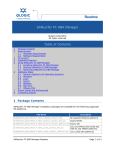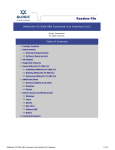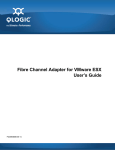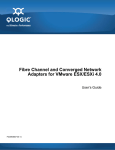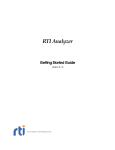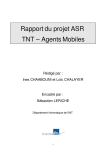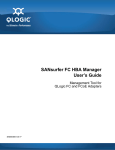Download Qlogic SANsurfer FC HBA Manager User`s guide
Transcript
SANsurfer FC/FCoE HBA Manager QLogic Corporation. All rights reserved. Table of Contents 1. Package Contents 2. Requirements 2.1 Hardware Requirements 2.2 Software Requirements 3. OS Support 4. Supported Features 5. Using SANsurfer FC HBA Manager 5.1 Installing SANsurfer FC HBA Manager 5.2 Starting SANsurfer FC HBA Manager 5.3 Removing SANsurfer FC HBA Manager 6. Additional Notes 6.1 General (Applies to All OSs) 6.2 Windows 6.3 Linux 6.4 Solaris 6.5 Netware 6.6 Mac OS X 6.7 VMware ESX 7. Known Issues and Workarounds 8. Contacting Support SANsurfer FC/FCoE HBA Manager Readme 1 of 11 1. Package Contents SANsurfer FC HBA Manager installation packages are available for the following supported operating system (OS) platforms (where “nn” specifies the build number of the current software release): File Name Description standalone_sansurfer5.0.1bnn_windows_install.exe All supported Windows platforms standalone_sansurfer5.0.1bnn_solaris_install.bin.gz Solaris SPARC standalone_sansurfer5.0.1bnn_solaris_install_x86.bin.gz Solaris x86 standalone_sansurfer5.0.1bnn_macosx_install.zip Mac OS X (Power PC/Intel) standalone_sansurfer5.0.1bnn_linux_install.bin.gz Linux/VMware ESX (Intel x86, Intel 64 and AMD64 platforms) standalone_sansurfer5.0.1bnn_linux_install_ia64.bin.gz Linux (Intel IA64 platforms) 2. Requirements This section lists the minimum hardware and software requirements. 2.1 Hardware Requirements SANsurfer FC HBA Manager requires the following minimum hardware: ● ● One or more of the following QLogic adapters: ❍ QLx2xxx FC Adapters (adapters) ❍ QLx8xxx FCoE Converged Network Adapters (adapters) Single-processor or multi-processor server or workstation: ❍ ● Pentium III with 450 MHz or greater for Windows XP Professional, Vista, Windows 2000, Windows Server 2003, 2008, Red Hat/SLES Linux, Solaris x86, or NetWare ❍ Sun Ultra 60 for Solaris SPARC ❍ Power Mac G5 1.8 MHz or greater with 512 MB of memory Fibre Channel devices, such as disks and RAID subsystems. SANsurfer FC HBA Manager supports most FC devices. For a complete list of devices that support failover, see the QLogic SAN Interoperability Guide, which you can download from the QLogic Web site: http://www.qlogic.com/interoperability/interoperability.aspx NOTE: Tape devices are shown as part of the configuration, but are not fully supported by SANsurfer FC HBA Manager (only LUN masking). ● ● ● 256 MB of physical RAM required to run SANsurfer FC HBA Manager; 512 MB recommended. Running with less memory can cause disk swapping, which severely affects performance. Video card capable of 256 colors and a screen resolution of 800 x 600 pixels required; 16K colors and 1024 x 768 pixels recommended About 150 Mb disk space SANsurfer FC/FCoE HBA Manager Readme 2 of 11 2.2 Software Requirements SANsurfer FC HBA Manager requires the following minimum software: ● Common desktop environment (CDE) to run the SANsurfer FC HBA Manager graphical user interface (GUI) QLogic QLx2xxx FC drivers for your OS platform ● QLogic QLFCoE Converged Network Adapter driver for your OS platform ● TCP/IP protocol for Windows 2000, Windows 2003, or Windows 2008 remote management ● TCP/IP protocol for NetWare remote management ● ● ● ● ● Java SE Development Kit (JDK) 1.5.0 on all platforms, except Linux PPC-64, Linux IA64, and Solaris SPARC Administrative privileges to perform management functions Internet Explorer (5.0 or later), Netscape Communicator (5.0 or later), or Firefox (1.0 or later) to view online help One of the operating systems identified in the OS Support section Disable user access control to run the agent service (qlremote) on Windows 2008 or Windows Vista 3. OS Support SANsurfer FC HBA Manager runs on the following OS platforms: Operating Systems OS Name OS Type Hardware Platform Windows 2000 32-bit Intel x86, Intel 64, AMD64 Windows Server 2003 32-bit Intel x86, Intel 64, AMD64 Windows Server 2008 32-bit Intel IA64, Intel64, AMD64 Windows XP Professional 32-bit Intel IA64, Intel64, AMD64 Windows Vista 32-bit Intel x86, x64 Solaris 10 and OpenSolaris 2008.11 x64, x86 Solaris 8, 9, and 10 for SPARC NetWare 6.5 32-bit Intel x86 Apple Macintosh: Mac OS X (Panther/Tiger/Leopard) 32-bit, 64-bit PowerPC or Intel Linux Red Hat RHEL AS/ES 5.2 32-bit, 64-bit Intel IA64, Intel 64, AMD64 Linux Red Hat RHEL AS/ES 5.3 32-bit, 64-bit Intel IA64, Intel 64, AMD64 Linux Red Hat RHEL AS/ES 4.7 32-bit, 64-bit Intel IA64, Intel 64, AMD64 Linux Novell SLES 11 GMC 32-bit, 64-bit Intel x86, AMD64 Linux Novell SLES 10 SP2 32-bit, 64-bit Intel IA64, Intel 64, AMD64 Linux Novell SLES 10 SP1 32-bit, 64-bit Intel IA64, Intel 64, AMD64 Linux Novell SLES 9 SP 4 32-bit, 64-bit Intel IA64, Intel 64, AMD64 Linux Novell SLES 9 SP 3 32-bit, 64-bit Intel IA64, Intel 64, AMD64 VMware ESX/ESXi 3.5 U4 32-bit VMware ESX/ESXi 3.5 U3 32-bit NOTE: For specific service packs (SP) and OS updates, refer to the descriptions where this software version is posted on the QLogic Web site: http://support.qlogic.com/support/drivers_software.aspx SANsurfer FC/FCoE HBA Manager Readme 3 of 11 4. Supported Features SANsurfer FC HBA Manager provides a graphical user interface (GUI) that lets you easily install, configure, and deploy QLogic Fibre Channel Adapters. It also provides robust diagnostic and troubleshooting capabilities and useful statistical information to monitor and optimize SAN performance. 5. Using SANsurfer FC HBA Manager This section provides the following procedures for using SANsurfer FC HBA Manager: ● 5.1 Installing SANsurfer FC HBA Manager ● 5.2 Starting SANsurfer FC HBA Manager ● 5.3 Removing SANsurfer FC HBA Manager For more detailed procedures, refer to the SANsurfer FC HBA Manager User's Guide. 5.1 Installing SANsurfer FC HBA Manager NOTE: On a JS20 or JS21 blade that has a previous version of SANsurfer FC HBA Manager, make sure that the previous version of SANsurfer has been completely uninstalled before installing this new version. If you attempt to re-install this update prior to uninstalling the previous version, the system will prompt you to remove the current tool. If you exported the display using the DISPLAY= method, a hidden window with no focus appears behind the main SANsurfer installation window. Although the installer appears to hang, it is actually waiting for you to take action on the hidden window. To install SANsurfer FC HBA Manager: 1. Go to the QLogic Driver Downloads / Documentation Web page: http://support.qlogic.com/support/drivers_software.aspx 2. Select the hardware type, model number, and operating system, and then click GO. 3. On the specific download page under Management Tools, select the SANsurfer FC HBA Manager installation file. 4. On the License Agreement, click I Accept. 5. To complete the installation, follow the instructions in the installation wizard. IMPORTANT: The default SANsurfer FC HBA Manager operation password is config. To ensure that security is not compromised, be sure to change this password after installing the tool. 5.2 Starting SANsurfer FC HBA Manager To start SANsurfer FC HBA Manager, follow the procedure for your specific operating system provided in the SANsurfer FC HBA Manager User’s Guide, “Getting Started” chapter. For Novell NetWare agent installation, when the SANsurfer installation is complete, you must start the SANsurfer FC HBA Manager agent using one of the following methods: ● Reboot the NetWare server where the agent was installed. ● On the NetWare server console where the agent resides, type the following commands: RPCSTART LOAD QLREMOTE.NLM NOTE: This instruction assumes that you have already loaded the QLogic Novell NetWare HAM driver. SANsurfer FC/FCoE HBA Manager Readme 4 of 11 5.3 Removing SANsurfer FC HBA Manager You must exit the SANsurfer FC HBA Manager installer before you uninstall SANsurfer FC HBA Manager. To remove SANsurfer FC HBA Manager, follow the procedure for your specific operating system provided in the SANsurfer FC HBA Manager User’s Guide, “Installing SANsurfer FC HBA Manager” chapter. NOTEs: ● While uninstalling SANsurfer FC HBA Manager from a NetWare server, the server’s prompt shows the following message: Cannot stat sys:etc/rpcnet.cfg You can ignore this message because it does not affect the NetWare server’s operation. ● The uninstall process does not remove specific files and directories. You must manually delete these files. 6. Additional Notes The following sections provide additional information according to operating system: ● 6.1 General (Applies to All OSs) ● 6.2 Windows ● 6.3 Linux ● 6.4 Solaris ● 6.5 Netware ● 6.6 Mac OS X ● 6.7 VMware ESX 6.1 General (Applies to All OSs) 6.1.1 Manually Mapping the Host Name to IP SANsurfer FC HBA Manager does not allow connecting to the same host more than once; doing so causes issues with policies and wastes system resources. Consequently, all host IP addresses must resolve to a host name to allow the connection to complete. If domain name service (DNS) is not used, you must edit the local host file on the system where you are running SANsurfer FC HBA Manager, and manually map the host name to the static IP address. The name and location of the host file for each OS are as follows: ● Windows: <install drive>:windows\system32\drivers\etc\hosts ● Linux: /etc/hosts ● Mac OS X: /etc/hosts ● Solaris: SANsurfer FC/FCoE HBA Manager Readme 5 of 11 /etc/hosts ● NetWare: Windows System’s NetWare client <install drive>: windows\system32\drivers\etc\hosts ● VMware: /etc/hosts 6.1.2 Enabling Failover During Installation During SANsurfer installation, the system prompts you to specify whether or not to enable failover. Enabling failover notifies SANsurfer how you want to create and validate the saved configurations. Selecting “enable failover” does not cause the platform-specific failover driver to load automatically. NOTE: Failover applies only to Linux hosts running the std driver. 6.1.3 Understanding the Displayed Hard Drive Size Under LUN Information Two different measurement formats are used when displaying the hard drive size: decimal (GB) and binary (GB). Both Linux and Windows show the correct number using their numeric format: ● Windows uses binary (numbers that are a power of 2). ● Linux uses decimal (numbers that are a power of 10). For example: 2^10 is 1,024. The closest decimal number is 10^3 or 1,000. 2^20 is 1,048,576. The closest decimal number is 10^6 or 1,000,000. 2^30 is 1,073,741,824. The closest decimal number is 10^9 or 1,000,000,000. 6.2 Windows 6.2.1 ConfigRequired Parameter Under Windows, the ConfigRequired parameter in the registry dictates how devices are seen by the OS. When ConfigRequired=0, both persistently-bound and new devices appear as enabled. This includes devices that might have been previously unconfigured using SANsurfer FC HBA Manager. You can set this parameter in the SANsurfer FC HBA Manager Driver Setting, “Present targets that are persistently bound plus any new target(s) found.” When ConfigRequired=1, only persistently-bound devices appear as configured. New devices or devices that were previously unconfigured using SANsurfer FC HBA Manager appear as unconfigured. You can set this parameter in the SANsurfer FC HBA Manager Driver Setting, “Present target(s) that are persistently bound only.” NOTE: For the new Windows driver (version 8.2.0.10 and later), you must set the ConfigRequired parameter to 1 to prevent the OS from seeing unconfigured entries. 6.3 Linux 6.3.1 Running SANsurfer FC HBA Manager and Connecting to a Remote Red Hat Linux Machine When running SANsurfer FC HBA Manager and connecting to a remote Red Hat Linux machine, you must modify the /etc/hosts files on the two machines to allow proper operation of asynchronous notifications from the agent to SANsurfer FC HBA Manager. SANsurfer FC/FCoE HBA Manager Readme 6 of 11 To resolve this issue, create a new entry with the host IP address assigned to ethx. Modify the existing entry by moving the hostname from the localhost line to the newly-created line. For example: Initial: 127.0.0.1 localhost runner.domain.com Modified: 127.0.0.1 localhost 10.0.0.1 runner.domain.com 6.3.2 Secure Portmapper For Linux 7.x and Advanced Server 2.1, SANsurfer includes a new secure portmapper. For remote communication to work properly between GUIs and agents, add the statement portmap:ALL to the / etc/hosts.allow file. 6.3.3 Changing the SANsurfer FC HBA Manager Password To change the current SANsurfer FC HBA Manager password, you must install the shadow password option on your Linux machine. To install the etc/shadow file on a Linux 7.2 machine, for example, follow these steps: 1. Install the shadow-utils rpm package from <Linux 7.2 CD-1>: /Red Hat/RPMS/shadow-utils-20000902-4.i386.rpm 2. To convert the passwords to shadow password format, go to the /etc file, and then type the pwconv command. 6.3.4 Non-Failover Version of Linux Driver When using the non-failover version of the Linux driver, disable failover by launching the Fibre Channel Port Configuration window. From the File menu, de-select the Enable Failover Configuration (host) option. 6.3.5 IA32 SANsurfer FC Manager Installer To run the IA32 SANsurfer FC HBA Manager installer under Linux x86_64 (Intel 64), you must install the IA32 X11 libraries. These libraries are included in the xorg-x11-libs-<version>.EL rpm. If the libraries are missing, the following exception appears: java.lang.UnsatisfiedLinkError: /tmp/install.dir.4191/Linux/resource/jre/lib/ i386/xawt/libmawt.so: libXext.so.6: cannot open shared object file: No such file or directory 6.3.6 SANsurfer FC Manager Installer on Red Hat 5 To run the SANsurfer installer on a Red Hat 5 Linux machine, when using the default installation, you must install the following rpms: ● compat-libstdc++-33-3.2.3-61.<arch>.rpm ● libXp-1.0.0-8.<arch>.rpm NOTEs: ● On x86_64 machines, load 32-bit libs. ● On ppc64 Linux machines, load both ppc64/ppc rpms. 6.3.7 Manually Starting IOCTL Module on RH 4.x Systems On RH 4.x systems, an IOCTL module is used to communicate between SANsurfer and the driver. If you are using a earlier version of SANsurfer (prior to 5.0.1b38), you must manually start the input/ SANsurfer FC/FCoE HBA Manager Readme 7 of 11 output control (IOCTL) module. After installing but before starting SANsurfer, execute the following command: # modprobe -a qioctlmod If qlremote is not running, you might need to start it. To check to see if qlremote is running, execute the following command: # ps -C qlremote If there is no output from the preceding command, then qlremote is not running. To start qlremote if it is not running, execute the following command: # /usr/local/bin/qlremote 6.4 Solaris 6.4.1 Target Persistent Binding On Solaris, the qla_mp_config_required parameter in the configuration file dictates how the OS sees devices. The qla_mp_config_required flag in the QLogic configuration file (qla2x00.conf) controls persistent binding of targets. The default configuration file that comes with the QLogic driver does not have an entry for this flag. An entry for this flag appears in the configuration file only after saving the target configuration data with SANsurfer FC HBA Manager. By default, SANsurfer FC HBA Manager sets the qla_mp_config_required flag to 1. When this flag is set to 1, only target devices that are persistently bound in the configuration file are reported to the OS. The driver does not report any new or unconfigured targets to the OS. In other words, the default behavior for this flag is “persistent targets only.” When the qla_mp_config_required flag is set to 0, the driver reports both persistently bound and new targets to the OS. This is equivalent to “persistent plus new.” NOTE: After saving the qla_mp_config_required parameter to the configuration file, the driver ignores the old, English-style persistent binding entries. For example: hba<#>-SCSI-target-id-<#>-fibre-channel-port-name="<device WWPN>"; 6.5 NetWare 6.5.1 Operating SANsurfer FC HBA Manager on NetWare 5.x/6.x Servers Operating SANsurfer FC HBA Manager on NetWare 5.x/6.x servers requires the Internetwork Packet Exchange/Sequenced Packet Exchange (IPX/SPX) network protocol. 6.5.2 Operating SANsurfer FC HBA Manager on NetWare To run SANsurfer FC HBA Manager on NetWare, you must modify the FILES and BUFFERS parameters in the CONFIG.SYS file (located on the NetWare server boot drive) as shown in the following example: FILES = 100 BUFFERS = 50 6.6 Mac OS X 6.6.1 Persistent Binding Bind By Port ID is not supported. The default driver setting is Bind By the WWPN. SANsurfer FC/FCoE HBA Manager Readme 8 of 11 6.7 VMware ESX 6.7.1 Operating SANsurfer FC HBA Manager on ESX 3.5 Servers Flashing/updating NVRAM has been disabled for QLE25xx adapters on ESX 3.5U2. 7. Known Issues and Workarounds The following sections describe the known issues and workarounds (if any) for SANsurfer FC HBA Manager. 7.1 File Choosers Issue: Periodically, the File Choosers in SANsurfer FC HBA Manager do not respond when trying to traverse the file system by double-clicking the icons. Workaround: To traverse the directory or open a specific file, select the directory, and then click the Open button. 7.2 Port Incorrectly Displayed in Adapter in Topology Issue: In specific switch zoning configurations, an attached port may appear in the topology as an adapter when it is not actually an adapter. Workaround: None 7.3 Administrator Account Password Issue: The administrator/admin enabled account password must not be blank when changing the SANsurfer HBA Manager password. Workaround: This is a Windows security restriction. 7.4 Running SANsurfer FC HBA Manager on an Itanium IA64 System Issue: When running SANsurfer FC HBA Manager on an Itanium I system, performance is hindered due to a Java compatibility issue. This issue is not seen with Itanium II systems. Workaround: None 7.5 Driver Parameters Revert to Their Default Values Issue: When updating the Windows driver using SANsurfer FC HBA Manager, the driver parameters revert to their default values: Present targets that are persistently bound plus any new target(s) found Workaround: Bind by world wide port name (WWPN). 7.6 Unsigned Windows Driver Update Issue: When performing a driver update on unsigned Windows drivers, the OS displays a confirmation dialog box. The dialog box appears in front of the SANsurfer (focus) when performing the update on the localhost if the GUI is connected to the “localhost” (non-agent). When updating a driver on the localhost, if the GUI uses the hostname or IP to connect, the confirmation dialog box appears behind the GUI (no focus). Workaround: If you are performing a driver update on the localhost, ensure that you connect “localhost.” 7.7 Portmapper Conflict Issue: If Microsoft Windows Services for UNIX is installed after SANsurfer FC HBA Manager, there is a Microsoft portmapper conflict. SANsurfer FC/FCoE HBA Manager Readme 9 of 11 Workaround: Follow these steps: 1. Temporarily uninstall SANsurfer FC HBA Manager. 2. Install Microsoft Windows Services for UNIX. 3. Re-install SANsurfer FC HBA Manager. 7.8 Connecting to localhost uses DLL/Shared Library (Windows or Linux IA32) Issue: Connecting to localhost on a Windows IA32 or Linux IA32 machine requires using a DLL/shared library instead of the agent. There is no communication between the localhost version and the agent. Workaround: Make sure that you use either the localhost or the agent, but not both at the same time. 7.9 HBA Parameters/Templates and Flash Updates on 8Gb Adapters with Windows Server 2008 Inbox Driver Version 9.1.4.5 or 9.1.4.6 Issue: SANsurfer FC HBA Manager does not support adapter parameters and Flash updates on 8Gb adapters if running the Windows server 2008 inbox driver version 9.1.4.5 or 9.1.4.6. Workaround: You must update the host to the latest QLogic driver. 7.10 'Warning: Cannot convert string "x" to type VirtualBinding' (Linux) Issue: When running either the GUI or the uninstall process on Linux, the message, 'Warning: Cannot convert string "x" to type VirtualBinding' appears. This is a Java issue where the window manager has already specified key mapping. Workaround: Ignore these warnings because they do not affect SANsurfer operation. 7.11 Information Left After Deleting Persistent Configuration (2.4 Kernel OS only) Issue: Deleting the persistent configuration does not remove the options qla2x00 ConfigRequired=1 ql2xuseextopts=1 string from the /etc/modules.conf file. Workaround: To fully delete all persistent data, you must manually edit this file. 7.12 Using the Hot Swap/Plug Features Issue: The hot swap feature does not work on QLogic FC adapters. Workaround: Stop the qlremote agent. For detailed instructions, see the online help. 7.13 Stale Semaphore Left Behind (Solaris) Issue: During normal operation of SANsurfer FC HBA Manager on Solaris, a stale semaphore may be left behind, causing all tools (SANsurfer FC HBA Manager and SANsurfer FC HBA CLI) to fail on load. Workaround: Manually remove the following two files: /var/tmp/.SEMD /var/tmp/.SEML 7.14 FCode/BIOS Update Not Available with Sun-branded 2Gb Adapters Issue: SANsurfer FC HBA Manager does not support FCode/BIOS update with Sun-branded 2Gb adapters. Workaround: None 7.15 Fixing Stack Issue with Limit Issue: When starting SANsurfer on Solaris, the following message may appear: Stack size of <x> Kb exceeds current limit of <x> Kb. (Stack sizes are rounded SANsurfer FC/FCoE HBA Manager Readme 10 of 11 up to a multiple of the system page size.) See limit(1) to increase the stack size limit. Workaround: None 7.16 Mac OS X Bug on SANsurfer FC HBA Manager Installer Issue: A Mac OS X bug affects SANsurfer installation on OS X 10.3.9 systems with the QuickTime 7.0.4 upgrade. This appears to only affect systems running version 10.3.9, and not version 10.4. Workaround: Revert to QuickTime 7.0.1 through a re-installer available from Apple on the Support/ Downloads page. 7.17 SANsurfer FC HBA Manager Does Not Start After Updating to Mac OS X 10.3.9 Issue: After updating to Mac OS X 10.3.9, SANsurfer does not install or start. Workaround: SANsurfer FC HBA Manager is a Java tool and is affected by this Java issue. For details, review the following article: http://docs.info.apple.com/article.html?artnum=301380 7.18 Windows Server 2008/Vista localhost Limits Issue: SANsurfer does not see adapters when connecting to localhost when running Windows Server 2008 or Windows Vista. Workaround: When running SANsurfer on Windows Server 2008 or Vista, you must disable UAC (User Access Control) before using localhost connects. 8. Contacting Support Please feel free to contact your QLogic approved reseller or QLogic Technical Support at any phase of integration for assistance. QLogic Technical Support can be reached by the following methods: Web: http://support.qlogic.com Email: [email protected] Go to Top © Copyright 2009. All rights reserved worldwide. QLogic, the QLogic logo, and the Powered by QLogic logo are registered trademarks of QLogic Corporation. All other brand and product names are trademarks or registered trademarks of their respective owners. SANsurfer FC/FCoE HBA Manager Readme 11 of 11











